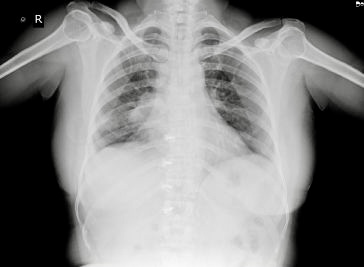Pedal edema and weakness in calf muscles
This is an online E log book to discuss our patient's de-identified health data shared after taking his/her/guardian's signed informed consent.
Here we discuss our individual patient's problems through series of inputs from available global online community of experts with an aim to solve those patient's clinical problems with collective current best evidence based inputs.
This E log book also reflects my patient-centered online learning portfolio and your valuable inputs on the comment box is welcome.
CASE:
A 28 yr old part time DJ. Currently owning a liquor shop presented to OPD with worsening weakness of both lower limbs since 2 days and swelling of lower limbs since 3 days.
Patient is apparently asymptomatic 3 days back then he noticed swelling in both of his both of his legs which is insidious in onset, progressive and pitting type and is extending upto ankle.
2 days back he noticed weakness in the both lower limbs and needs to halt a lot while he was walking and was comfortable on short steps, subsequently the next morning (present day ) as he was going down the stairs he had a history of fall and was able to get up with the help of his wife.
He has a feeling of giving way while walking, which requires him to take support intermittently.
He has difficulty in getting up from squatting position in the bathroom since morning, tingling confined to both the palms since morning.
He noticed tingling sensation of both lower limbs since one week and upper limbs from 2 days which is not associated with any sensory loss and is able to feel the surface of floor.
He is able to roll on the bed, no bowel and bladder involvement, no weakness in upper limbs.
He was brought to OPD for further evaluation of his condition.
PAST HISTORY:
He was his usual self 6 months ago and first noticed swelling in both his feet which was insidious in onset, progressive, pitting type upto ankle ( he was unable to wear his own footwear ) which subsided on its own after 20 days, associated with palpitations occasionally and not associated with sweating and breathlessness.
He went to Osmania general hospital for further evaluation of pedal oedema and was discharged as investigations turned out to be normal and gave alcohol as cause for his oedema and was advised him to stop consuming it.
He had on and off pattern of pedal oedema extending upto his ankle and usually subsided on its own and wasn’t bothered until one month back he came to our hospital for evaluation of swelling in both of his legs.
Not a known case of diabetes, hypertension, asthma, tuberculosis, epilepsy.
PERSONAL HISTORY:
He has a mixed diet with normal appetite and adequate sleep. His bowel movements are regular with normal bladder filling.
He started drinking alcohol since he was 17 yr old (peer pressure) and started consuming 3 or 4 times a week preferably whiskey ( 90 -180ml ) including festivities then stopped alcohol over a month as he was advised against it 6 months ago.
From the past 10 days he developed pedal oedema facial puffiness, decreased urine output, hematuria and frothy urine, abdomen distension and was subsided on its own
1 week back he developed fever with chills insidious onset with no diurnal variation ( after a meal at his sisters house ) associated with dry cough occasionally subsided on medication which reverted back the next morning and took consultation from a local doctor and it was subsided.
GENERAL EXMINATION:
Patient is conscious, coherent, cooperative with moderate built and moderate nourishment.
No pallor, icterus, cyanosis, clubbing, lymphadenopathy.
Pedal oedema is present bilaterally and is of pitting type extending upto ankle.
VITALS:
BP: 120/80 mmgh
PR: 75 BPM
RR: 18 CPM
TEMP: afebrile.
GRBS: 101
SPO2: 98%.
SYSTEMIC EXAMINATION:
CVS: S1 and S2 heard.
RS: Bilateral air entry present.
P/A: Scaphoid abdomen, no tenderness, no local rise of temperature, no palpable masses, hernial orifices are clear, no free fluid, no organomegaly, bowel sounds heard.
ON NEUROLOGICAL EXAMNATION:
Patient is conscious, coherent and cooperative and is well oriented to time, place and person.
HMF: intact.
Cranial nerves: All normal.
MOTOR SYSTEM:
BULK: UL LL
R. n n
L n n
TONE:
R n n
L n. n
POWER:
R - proximal: n 4-/5
distal : n. 5/5
L - proximal: n 4-/5
distal. : n. 5/5
REFLEXES : all the superficial and deep tendon reflexes are absent.
RHOMBERG'S SIGN: positive.
PROVISIONAL DIAGNOSIS: ? GB secondary to viral cause ?
? Beri beri due to alcohol consumption ?
INVESTIGATIONS:
1) CBP:

2) CUE:
3) RFT:
2D-ECHO report: - RA dilated, EF - 55 %, IVC dilated, No RWMA, No ASWS, good LV systolic function, No diastolic dysfunction, No PE.
DIAGNOSIS:
WET BERI BERI DUE TO ALCOHOL CONSUMPTION.
TREATMENT GIVEN:
1) DAY 0:
BP: 120/80 mmgh
PR: 75 BPM
RR: 18 CPM
TEMP: afebrile.
GRBS: 101
SPO2: 98%. on RA
Plan for treatment:
a) INJ. OPTINEURON 1amp in 100 ml NS/IV/OD.
b) TAB. PREGABALIN 75mg/OP/HS.
2) DAY 1:
BP: 110/90 mmgh
PR: 72 BPM
RR: 17 CPM
TEMP: afebrile.
SPO2: 98% on RA.
CVS: S1 and S2 heard.
RS: BAE present.
P/A: soft and non tender.
Plan for treatment:
a) INJ. OPTINEURON 1amp in 100 ml NS/IV/OD.
b) INJ. THIAMINE 2 amp in 100ml NS/IV/TID.
c) INJ. LASIX 40 mg/IV/BD.
3) DAY 2:
BP: 130/80 mmgh
PR: 72 BPM
RR: 17 CPM
TEMP: afebrile.
SPO2: 98% on RA.
CVS: S1 and S2 heard.
RS: BAE present.
P/A: soft and non tender.
Plan for treatment:
a) INJ. OPTINEURON 1amp in 100 ml NS/IV/OD.
b) INJ. THIAMINE 2 amp in 100ml NS/IV/TID.
4) DAY 3:
BP: 130/80 mmgh
PR: 72 BPM
RR: 17 CPM
TEMP: afebrile.
SPO2: 98% on RA.
CVS: S1 and S2 heard.
RS: BAE present.
P/A: soft and non tender.
Plan for treatment:
DISCHARGE SUMMARY:







